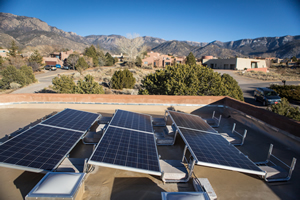Things to Consider When Selecting an Aluminum Extrusion Supplier
 As the solar market continues to grow, managing logistics and supply chains are essential in order to stay competitive. Working with suppliers, including aluminum-extruded racking system suppliers, can add value beyond the cost of parts, help reduce risk, keep construction timelines on schedule, and improve site installation quality. In order to ensure a solar project will end with the highest quality solar racking systems, it is important to begin the project with thorough research and enlist suppliers who help create a strong supply chain.
As the solar market continues to grow, managing logistics and supply chains are essential in order to stay competitive. Working with suppliers, including aluminum-extruded racking system suppliers, can add value beyond the cost of parts, help reduce risk, keep construction timelines on schedule, and improve site installation quality. In order to ensure a solar project will end with the highest quality solar racking systems, it is important to begin the project with thorough research and enlist suppliers who help create a strong supply chain.
A solar project developer and the entire team of engineering, procurement, and construction (EPC) partners with whom they work can mitigate supply chain risk by considering these crucial factors.
Doing homework on potential suppliers
Actively managing a supply chain starts with investing time researching potential partners. When selecting an extruded aluminum supplier, learn as much as possible about its manufacturing capabilities, capacity, and financial health. Look into quality processes, delivery performance, and successes and failures with PV racking and support systems. Ask for references from past projects to get a first-hand opinion. Seek performance data that provides insights into increased risk and potential extended installation time, including product-manufacturing defects, shipping delays, or too much product shipped at once. Ask about the aluminum extruder’s relationship with its raw material supplier.
Selecting a manufacturing supplier that has a strong history in the solar market is equally important. Ideally, the supplier has the necessary resources to support the project as well as relevant knowledge of the renewable energy market.
Once a racking support system supplier has been selected, the next step is to meet with the developer, EPC, and supplier to discuss project details such as, the component manufacturing timeline, shipping and delivery schedule, and on-site assembly. Ensuring consensus at the project’s start mitigates risk and helps the solar field installation go as smoothly as possible.
Determining the optimal racking system
Developers need to factor in power generation needs, site terrain, and location climate when choosing the appropriate racking system. The geographical location and site design will dictate whether tracking systems or fixed tilt structures are needed to create the best solution for capturing the most solar energy. For example, an installation site prone to variable weather conditions may require a racking system with moving parts to track the sun, and that system may require more maintenance than a fixed tilt system.
Another top consideration for racking systems is cost. When factoring in cost, examine additional offerings from the chosen supplier. Consider total-cost-of-purchasing criteria beyond initial purchase price. Developers and EPCs should fully understand their component manufacturing needs and work closely with the suppliers that can meet them.
Additional fabrication processes, such as machining, finishing, or welding can add to total cost as well. Determine if any of these additional processes will be performed in-house, or by the supplier’s vendor partners. Outsourcing these processes may increase shipping costs, timelines, and handling, which also presents more opportunity for potential damage. To maintain better control over the supply chain, consider working with an aluminum extrusion supplier that offers multiple fabrication services to meet all of the projects needs.
Ship strategically
It is also critical that the developer or EPC determine the shipping schedule in advance. Will the components be shipped all together, or will they be delivered in sets of smaller shipments that are easier to manage on-site as the installation progresses? Staggering the delivery schedule may be preferred to ease off-loading and installation timing for workers at the job site. Components shipped all at once will need to be stored on-site or nearby until the racking systems are ready to be installed. In addition, planning to have someone on-site to manage delivery and assist in off-loading the support structures can ease site installation issues.
Create a back-up plan
Unfortunately, unforeseen problems can arise throughout the supply chain, which is why planning and creating back-up plans is so crucial. For example, if a severe weather event, such as a tornado affects a component manufacturing facility, have a plan to use an alternative facility to supply necessary racking components to keep the project on schedule.
Before a project begins, sit down and create a risk analysis model to outline all potential problems and solutions. The risk analysis model can be detailed or simple, but the initial planning can help reduce headaches or delays down the road.
Partner with a vertically integrated supplier
One of the most common added costs of managing a solar installation project is outsourcing component manufacturing from multiple suppliers. Managing these complex relationships can be a challenge, taking a significant financial and logistical toll on the project and slowing processes down.
Instead of having different suppliers doing different tasks, select a partner who offers a vertically integrated supply-chain solution; combining manufacturing expertise with value-added services like ease of purchasing, engineering assistance, production, finishing, and strategic shipping. This can add extra value to the developers’ needs by doing more of the component manufacturing for them.
Properly assessing the ideal supply chain partners requires that developers and their EPCs devote additional time and research to choose the appropriate and most qualified supply chain partners. The return on that investment includes reduced risk, on-schedule construction timelines, and higher site installation quality, all of which will generate, and deliver the valuable renewable solar energy that is expected.
Mark W. Turley is the solar market leader for Alexandria Industries. He helps solar project developers and EPCs bring to life effective supply chain and cost management strategies.
Alexandria Industries | www.alexandriaindustries.com
Volume: July/August 2015









.jpg?r=5452)
.jpg?r=8701)
.gif?r=5286)
